#Roi Cooper Megrue
Explore tagged Tumblr posts
Text
UNDER FIRE
1915
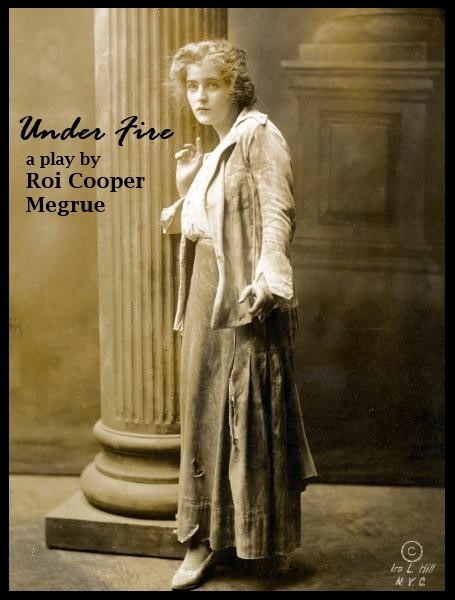
Under Fire is a play by Roi Cooper Megrue. It was originally produced by Selwyn & Company and co-directed by Megrue and its star, William Courtenay. The original production also featured Violet Heming (above), Frank Craven (who played an American reporter named Charlie Brown), and, in the ensemble, Edward G. Robinson.
The play was presented in London the previous season. At the time of production, the United States had not yet officially entered World War One (aka ‘The Great War’) which didn’t happen until April 6, 1917.
The play was billed as “a new play of today, tomorrow, and yesterday.”

This was the second of Megrue’s “Under��� plays. The first was 1914′s hit Under Cover, and the third, and least successful, was 1916′s Under Sentence. All three were produced by Selwyn and Co. The first two were seen in Atlantic City featuring William Courtenay.

Megrue, however, denied that the use of the ‘Under’ titles was intentional. The plays are thematically unrelated. However, creating a third title containing ‘Under’ makes it difficult to claim it was not intentional.
"Under Fire" concerns itself with an adventurous and lovable young Irishman, (William Courtenay), who, finding himself in England at the beginning of the war after several years of foreign service, goes to Belgium with the first expeditionary force when England declares war. In England, he rediscovers the woman he loved, whom he had left years before because his poverty prevented him asking her to exchange her life in the most exclusive London society, where both her wealth and her charm placed her, for the nomadic existence of the wife of a young officer. By a striking chain of events, she finds herself In a position where she cannot accept his suit, nor tell him why, but she promises that in the great war game he is entering she will help him. The very circumstance which prevents her from becoming engaged to the Irish captain sends her into Belgium almost as soon as he goes. They meet, and to all appearances, are on opposite sides of the great struggle.
It was claimed that the company for the played number 150 with 50 speaking parts.
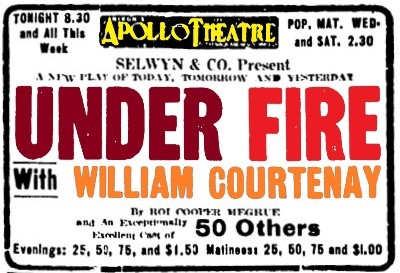
Under Fire premiered in Atlantic City at Nixon’s Apollo Theatre on the Boardwalk on May 24, 1915. Unusually, the play held an invited dress rehearsal for actor and managers who could not be away from New York City on its opening night.


On August 5th, the play was seen at the Broadway Theatre in Long Branch NJ.

Under Fire opened on Broadway on August 12, 1915 at the Hudson Theatre (141 West 44th Street).
About the Venue: The Hudson was bult in 1903. It was most often used as a TV studio in the 1930s, 40s, and 50s. In 1974, it was a blue movie theatre. In 1980, it became the Savoy, a rock club. In 1987, it received landmark status, so it was incorporated it into the adjacent Millennium Broadway Hotel as a conference center and auditorium. The venue re-opened as a legitimate Broadway theatre in 2017.

Like Under Cover, a novelization of the play was published in 1916, It was co-authored by Richard Parker, published by The Macaulay Company. The book was serialized for newspapers.
“In order to discourage the audiences at the Hudson Theater from taking sides during the performances of Roi Cooper Megrue’s ‘Under Fire,’ Selwyn and company have inserted a notice in the program requesting that no member in the audience indulge in any unpleasant demonstrations which might be offensive to others in the audience, or to those on the stage.” ~ BROOKLYN DAILY EAGLE
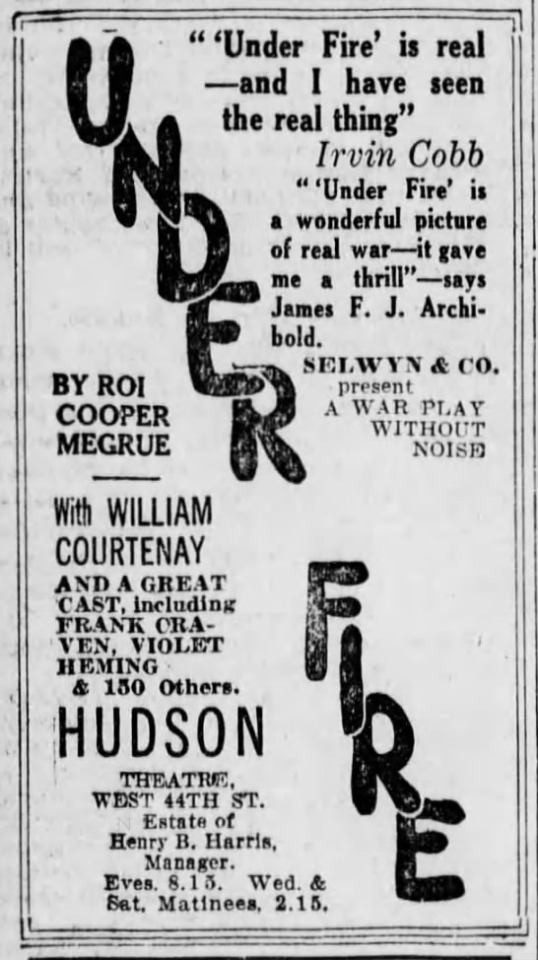
"’Under Fire’ may well be Judged by German sympathizers as out-and-out anti-German propaganda. With probably the best Intentions in the world, and with an apparent effort to be fair at least, Mr. Megrue has nevertheless moved a load of dynamite into the Hudson Theater and placed it under fire.” ~ BROOKLYN DAILY EAGLE
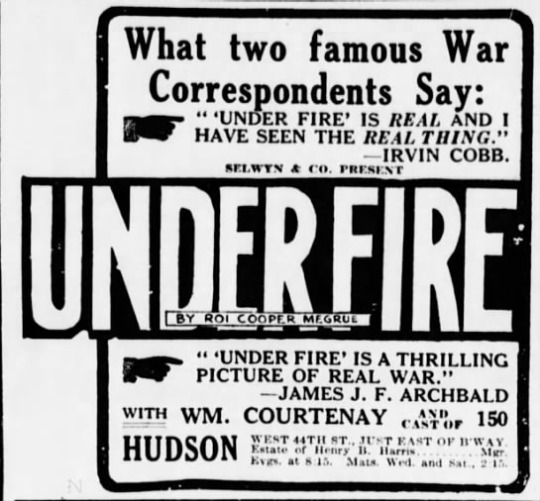
“’Under Fire’, while dealing with certain phases of the Great War, attempts to be neutral, although its characters being English, Belgian, French, and German, are naturally partisan.” ~ Samuel French Acting Edition of the Play, 1918
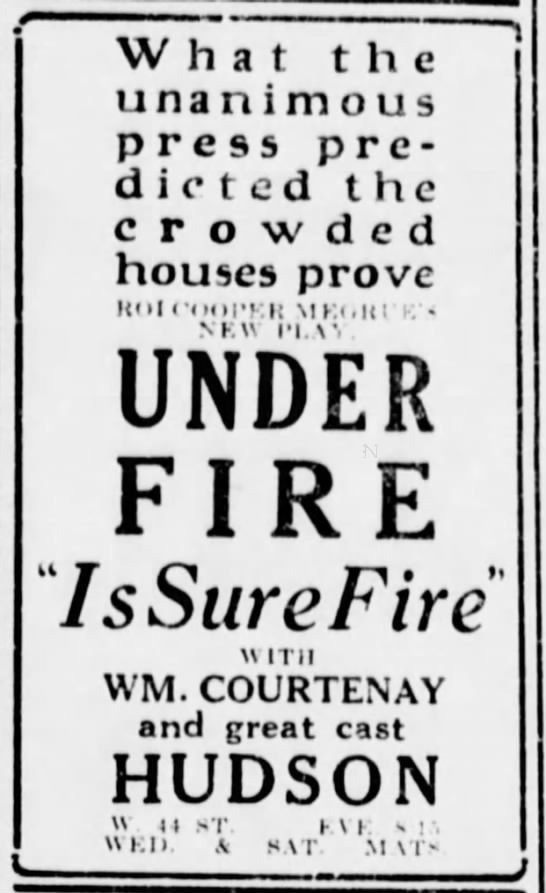
“[The trench scene] is a masterpiece of the stage architect. As one critic put it, ‘A sky brilliant with stars, a soldiers’ game of cards, the sentries on watch, the bursting of bombs and signal lights, and finally the aerial mine that ends all —Belasco never created anything more perfect.’” ~ BRETT PAGE, AUSTIN AMERICAN STATEMENT
Although Belasco was noted for his plays’ technical proficiency, he did not like Megrue’s writing. He must have changed his mind, however, because he produced Megrue’s play Seven Chances, which ran concurrently with the third ‘Under’ play Under Sentence in the second half of 1916.
The Broadway production of Under Fire ran for 129 performances, and then decamped to Boston’s Park Square Theatre. From there it embarked upon a tour of the North East: Massachusetts, New York State, and Pennsylvania.
In early 1916, a production opened in Sydney Australia at the Criterion Theatre.

In April 1916, the play was presented in Brooklyn, first at the Shubert, then at the Montauk.
On May 1, 1916 it was presented at Philadelphia’s Forest Theatre. The role of Charlie Brown, formerly played by Frank Craven, was taken by Frank Morgan. By this time, Megrue and Selwyn began planning production of their next Under play, Under Sentence. Also in 1916, Edward G. Robinson made his film debut. It would be the movies, not the stage, that catapulted the actor to fame. In 1973, he posthumously received an honorary Academy Award, accepted by his wife Jane.
#Under Fire#Roi Cooper Megrue#Under Cover#1915#Atlantic City#Broadway#Broadway Play#Edward G. Robinson#Frank Craven#Frank Morgan#Violet Heming#William Courtenay#World War One
2 notes
·
View notes
Photo

#42 Seven chances [Siete ocasiones] (1925) (Keaton)
Escrito por Luis Enrique Ruiz en su libro Obras maestras del cine mudo. Época dorada (1918-1930):
“Basándose en una obra teatral de Roi Cooper Megrue, Las novias enloquecidas, que ha obtenido escasa repercusión en los escenarios, los gagmans habituales de Buster Keaton: Havez, Bruckman y Mitchell, trabajan junto al propio Keaton en el guión del film Seven Chances. En él, los guionistas componen sobre la marcha una equilibrada historia con dos premisas como principales pilares argumentales: la premura de tiempo impuesta para el cobro de una herencia y una trepidante persecución final.
La película se divide en dos partes bien diferenciadas. La primera es una comedia de costumbres, donde se nos van dando a conocer los personajes, y contiene sobresalientes gags como los diferentes tipos de proposiciones-rechazos de los que el joven Shannon es protagonista. A partir de la escena de la iglesia, la cinta adquiere un ritmo desenfrenado, que va progresivamente en aumento hasta el final. A una colosal persecución, en la que varios cientos de mujeres corren tras el infortunado héroe, sigue un peligroso descenso por una colina, donde Keaton debe de sortear un alud de gigantescas rocas, algunas de las cuales, a pesar de ser de cartón-piedra, llegan a alcanzar los cien kilos de peso.
En Seven Chances, el personaje de Keaton ve cómo las circunstancias adversas determinan, una vez más, su conducta a seguir, y su particular manera de hacer las cosas provoca que el entorno hostil en el que se mueve habitualmente, se vea aquí amplificado. Afortunadamente, el amor, al final, mueve montañas, y entonces hasta el factor tiempo se alía con él.
La película se estrena el 16 de marzo de 1925 en el Capítol Theatre de Nueva York, obteniendo un éxito importante entre el público. Parte de la crítica, sin embargo, la acoge con reservas, considerándola excesivamente larga para su gusto.”
0 notes
Text
Seven Chances (1925)
https://dailymotion.com/video/x6hgv77 Seven Chances (1925) A man learns he will inherit a fortune if he marries by 7 p.m. that same day. Director: Buster Keaton Writers: Roi Cooper Megrue, Clyde Bruckman Stars: Buster Keaton, Ruth Dwyer, T. Roy Barnes Comedy, Romance http://www.imdb.com/title/tt0016332/
View On WordPress
0 notes
Text
UNDER COVER
1913-1915

Under Cover is a melodrama in four acts by Roi Cooper Megrue. It was originally produced by Selwyn & Company starring William Courtenay as Denby and featuring Lilly Cahill as Ethel.
‘Under Cover’ is a high society thriller set in Paris and Long Island NY.
In Paris, Ethel Cartwright meets dashing Steven Denby, who, unbeknownst to her, is a jewel smuggler who steals her $200,000 pearl necklace. Back in New York, Ethel notices her necklace is gone and claims the insurance money. The insurance examiner finds the Ethel's sister Amy suspicious and has her investigated by Taylor, a customs inspector. Amy soon confesses that she is the thief. Taylor tells Ethel he will forget the whole story if she helps him frame Denby. Ethel agrees. About to be taken to jail, Denby offers Taylor $30,000 to release him. Taylor accepts the bribe and Denby reveals that he is a secret service agent in charge of catching Taylor, who has been taking bribes from smugglers for several years. Ethel eventually marries Denby.
Megrue's play was considered revolutionary for 1914 for introducing the final twist: the true identity of the hero was kept secret until the very end of the play. Megrue wrote, in a 1914 article, that during tryouts he gave in one night to the advice of convention and let the audience into the secret in the proper place - the second act - after which “at the end of the third act the entire lot got up in a bunch and walked out”.

When the play was initially presented at Boston’s Plymouth Theatre in October 1913, it was attributed to Lawrence Haile, Megrue’s nom de plume. It was so successful that a second production was planned for Chicago, this time under the playwright’s real name. The play closed in Boston on July 4, 1914 after 27 weeks of steady business. But Beantown could look forward to a new Megrue play for Christmas.

Planning the Broadway and Chicago productions, it was decided to open them simultaneously - within an hour of one another (due to time zone differences). Unfortunately, this didn’t quite work out. The Chicago production opened on September 6th at Cohen’s Grand Opera House and the Broadway production on August 26th at the Cort.

After the Boston production closed, the play was novelized, illustrated with photos from the play. At the end, the book advertised the New York and Chicago stage productions.

As if all that weren’t enough, the Selwyns then brought the play back to the Plymouth in Boston, starring Rockcliffe Fellows and Jean Haven, making three major productions running at once. The Beantown re-berth happened on August 8, 1914. Although the Chicago / New York openings didn’t happen on the same day, another simultaneous opening did - Boston and Atlantic City! These were in the same time zone so the hour difference was no longer a factor.

Under Cover opened at the New Nixon Theatre (later known as the Globe) on the Boardwalk in Atlantic City on August 8, 1914. Nixon also operated the Apollo Theatre on the Boardwalk, Atlantic City’s premiere play incubator.

Under Cover opened on Broadway at the Cort Theatre (now the James Earl Jones) on August 26, 1914. It ran for 349 performances. Meanwhile, the Boston company toured New England and Canada.

Two weeks later, another play by Megrue, It Pays To Advertise, also opened on Broadway, this one at George M. Cohan’s Theatre on Broadway and 43rd. It, too, ran more than a year, meaning that Megrue had two plays on Broadway within six blocks of one another for a solid year. Although Under Cover was a big hit, It Pays To Advertise was a mega hit, spawning two films and three television adaptations. On Broadway, it out-ran Under Cover by 50 performances.

In 1916, Under Cover was filmed starring Owen Moore and Hazel Dawn.

The film opened in Atlantic City at the Colonial Theatre (on Atlantic Avenue, later known as the Center Theatre) on July 27, 1916.

A one-hour radio adaptation was presented on Lux Radio Theatre on April 27, 1936, starring Richard Barthelmess and Sally Eilers.
#Under Cover#Roi Cooper Megrue#Selwyn#William Courtenay#Broadway#broadway play#Boston#Chicago#Theatre#Cort Theatre#Atlantic City#1914
2 notes
·
View notes
Text
IT PAYS TO ADVERTISE
1914

It Pays To Advertise is “a farcical fact in four acts” by Roi Cooper Megrue and Walter Hackett. The original production was produced by George M. Cohan and staged by Sam Forrest.

The play is all about Rodney, the son of a wealthy soap magnate. The young man has no ambition, but his father wishes to make a man of him, so he conspires with his secretary to win the young man's affections, whereupon the father will turn his back on his offspring. Rodney meets the publicity agent of a defunct musical show, and quickly decides to enter business and show his father that he is a chip off the old block. He gets the idea of becoming a soap magnate himself and beating his father at his own game. The old man becomes convinced that advertising pays, and Rodney finds himself rich and married to the girl he loves.

The cast included: Ruth Shepley, George Schaeffer, Louise Drew, Grant Mitchell, John Cope, Will Deming, Cecile Bretonne, Harry Driscole, Vivian Rogers, WJ Brady, Kenneth Hills and Sydney Seaward.

It had its world premiere at Nixon’s Apollo Theatre on the Boardwalk in Atlantic City, New Jersey, where it opened on April 27, 1914. The above image of the theatre has all its neighboring supporters incorporated into the artwork, proving that ‘it pays to advertise’.
“Oh! You don’t believe in advertising? I guess you do. What makes you go to the theatre? Don’t tell me; I’ll tell you. It’s something you’ve been told about a play. And what you’ve been told, the other fellow’s been told and the fellow that told him read it somewhere. Ninety-five percent of the public are sheep, and all you’ve got to do is start them right and they’ll follow each other trying to follow the leader!” ~ RODNEY

It opened on Broadway on September 8, 1914, at the Cohan Theatre and ran for nearly a year.
At this time in theatre history, plays took curtain calls after each act instead of just at the end. Most times these were the usual bows, but plays like It Pays To Advertise staged tableau scenes. These were also written into the prompt script for future staging.

"George M. Cohan is very clever at picking winners." ~ THEATRE MAGAZINE

A novelized version of the play adapted by Samuel Field for Grosset & Dunlap in 1915.

The novelization (and likely the play) mentioned Atlantic City and Young’s Pier. The pier was built by Captain John L. Young in 1906.

Young’s Million Dollar Pier had what was claimed to be the world's largest ballroom, as well as a Hippodrome Theater with 4,000 seats, Exhibit Hall, Greek Temple, aquarium and a roller skating rink. In 1908 Young built a mansion on the pier for himself, with the address as "No. 1 Atlantic Ocean." At the ocean end of the pier, there were daily fish net hauls that were often directed by Captain Young himself.

That same year (1915) the play left New York and went back on the road, where it once again played at Nixon’s Apollo Theatre in Atlantic City. It was then hailed as “the funniest farce in the world”.

The playwrights substantially rewrote the play for a new production in London by the actor-manager Tom Walls, at the Aldwych Theatre. This opened on February 2, 1924 and ran a total of 598 performances.

The play was filmed four times: a silent film in 1919 starring Bryant Washburn;

It played in Atlantic City at the Viriginia Theatre on the Boardwalk on December 5 and 6, 1919.

...and a talkie starring Carole Lombard in 1931. It opened in Atlantic City on the famed Steel Pier, just a few steps away from the Virginia, where the silent film had played.

From there it moved to the Embassy, and the Royal (later the Hollywood Theatre), both on Atlantic Avenue.
There was also a French film 1932, and a Swedish film in 1936.
There were also three television adaptations: in 1949 (featuring a young Tony Randall); 1952 (featuring Roddy McDowell); and a British teleplay in 1957.

The Yale Rep presented the play in December 2001, and a New York production was staged in May 2009 by the Metropolitan Playhouse Company.
#It Pays To Advertise#Atlantic City#Roi Cooper Megrue#Walter Hackett#Broadway#Broadway Play#Carole Lombard#Nixon's Apollo Theatre#George M. Cohan#George M. Cohan Theatre#1914#Young's Million Dollar Pier#Farce#advertising#comedy
1 note
·
View note
Text
HONORS ARE EVEN
1920-1921

Honors are Even is a three act play written by Roi Cooper Megrue. The original production was staged by Megrue and produced by The Selwyns.

The story revolves around the daughter of a prominent playwright, Belinda Carter. She’s part of the idle, fashionable, wealthy set. During the course of the play, we see her proposed to by three ardent and entirely different young men.
A pre-Broadway tour began in Washington DC in November 1920, and visited Pittsburgh, Akron, Hartford, and Boston, where it stayed for 16 weeks. It eventually opened on Broadway at the Times Square Theatre (now the New Victory) on 10 August 10, 1921 and closed in October 1921 after 70 performances. It starred William Courtenay, Lola Fisher, Clifford Dempsey, Paul Kelly, Ambrose Martin, Henry Mowray, Horace Pollock, Laurence Redmond, Ralph Simone, Horace Sinclair, Mabel Stanton, Eleanor Woodruff, and Boots Wooster.

Atlantic City was not the first out-of-town venue to get the honor of hosting Honors. The Great Wooden Way would have to wait almost nine months, being the last city before opening on The Great White Way in early August 1921. The consolation was that the first act curtain of Honors rose on a depiction of the Atlantic City Boardwalk!


The opening stage direction refers to a “wheel-chair”. This is not the mobility device that we now associate with those with physical disabilities, but what are now called rolling chairs, a staple conveyance on the Atlantic City Boardwalk still in use today.

The characters being of considerable means, a beach scene in winter is set in Palm Beach, Florida, not Atlantic City, New Jersey. It was a remarkable escape, especially for Bostonians in mid-winter, where the play had its most lengthy stay.

Even the cast was concerned with the Boston winter weather!

In Boston, the Selwyn’s used the author’s prior success in Bean Town for a New Year’s advertisement, wishing the play an equally successful opening on January 1, 1921.


For the most part, the reviews were good - if a bit less than ecstatic. But Roundtable wit Dorothy Parker opined differently:
“...it was sweet, clean, wholesome and... dull.”

Another reviewer concurred with Parker.

After the mediocre reviews, press releases and gimmicks were created to keep the play’s name in front of the public. One of the subjects was criticism itself! Star Lola Fisher gave her opinion - and a photo shoot to boot!

She wasn’t above discussing her tastes in household pets either.

Or her love of anagrams!

Another gimmick used by the Selwyns was a ticket give-away. The lucky winner not only got two seats to the play, her photo and name in the Boston papers, but also heard her name spoken within the dialogue of the play! During the ‘telephone scene’ in the second act, William Courtenay’s character makes a quick telephone call to reach the “little church around the corner” and thanks [insert winner’s name] the operator, for her help.

Other operators who won included Anna Ahern (of the Fort Hill Exchange), Helen D. Gray (of the Back Bay Exchange), Marion F. Tibbetts (of the Richmond Exchange), Margaret L. Donovan (of the Brookline Exchange), Hazel S. Thomas (of the Bench Exchange), Ruth C. Peckenham (of the Cambridge Exchange), Anna Harrison (of the Richmond Exchange), and others. The promotion was during the dog days of February 1921, when attendance waned.

After 16 weeks in Boston, the show finally moved on to play other New England theatres. It then took a short break (for the sanity of its two stalwart leads), and - at long last - it briefly returned to the location where its opening scene is laid - Atlantic City.

An August heatwave delayed the Broadway opening. In 1921, air conditioning was not the norm in Broadway theatres. Others attributed the delay to avoiding competition from other openings on the selected date.
FAST FORWARD TO THE FORWARD...

In the 1924 acting edition of the play, the ‘Forward’ is written by Megrue from the point of view of the play itself, trying to account for its faults and failures while working in a backhanded dedication to his mother and grandmother.
#Roi Connor Magrue#Atlantic City#Boardwalk#Honors are Even#Selwyn#Lola Fisher#William Courtenay#Boston#Broadway#Roi Cooper Magrue#Play#1920#1921#Out-of-Town Tryouts#Dorothy Parker
0 notes